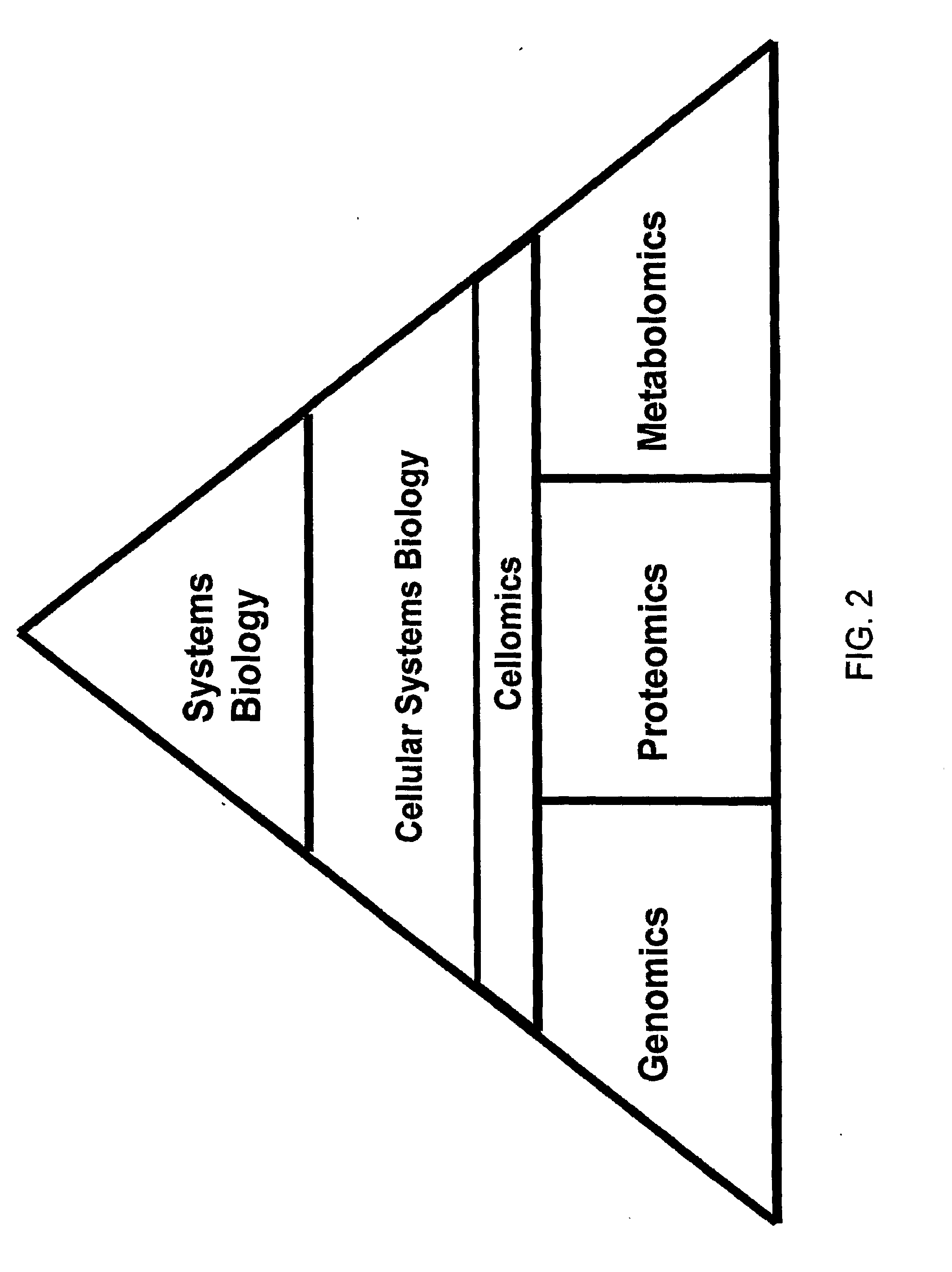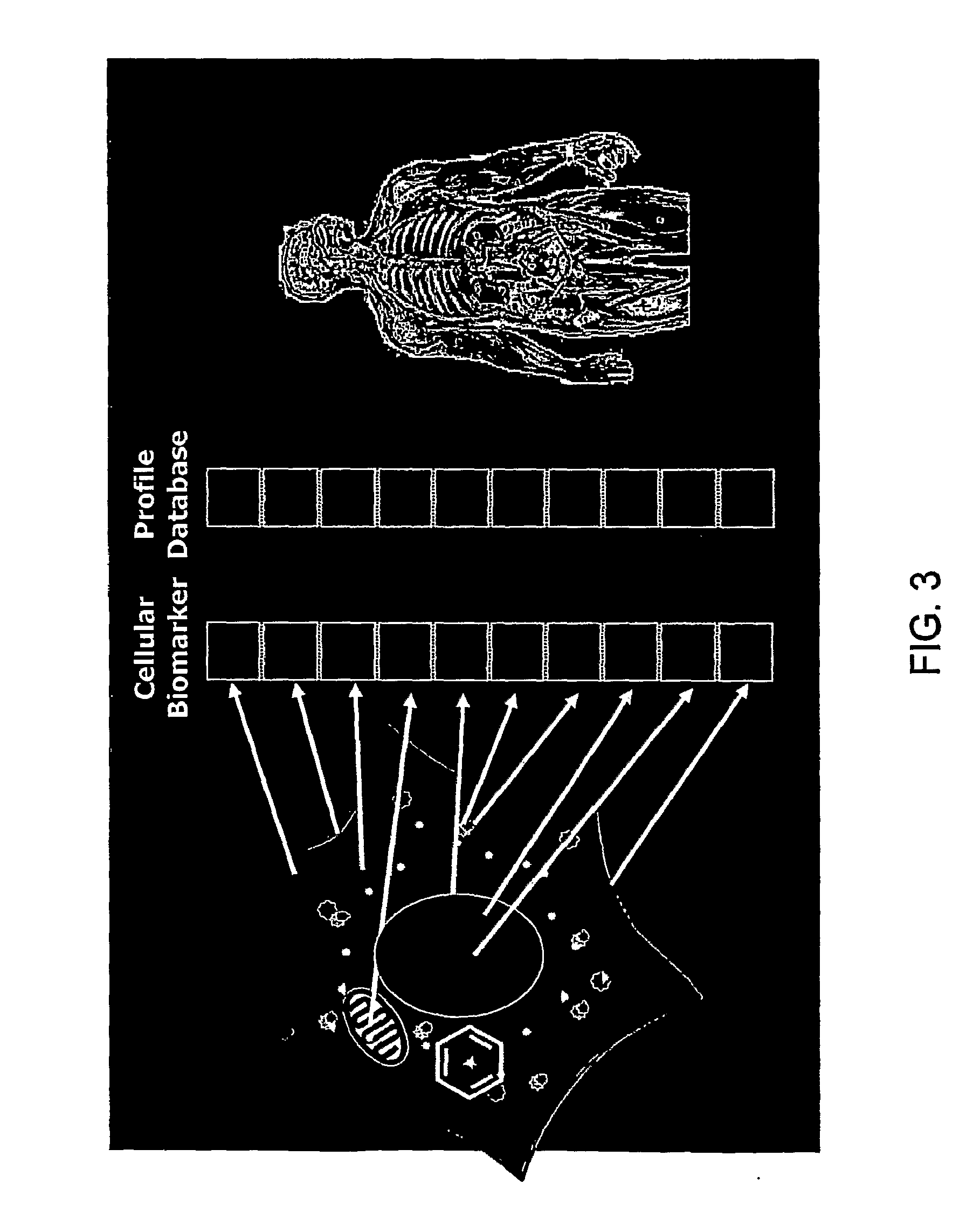Method for Modeling a Disease
a disease and disease technology, applied in the field of disease modeling, can solve the problems of reduced approach to drug discovery that has not delivered the promised efficiencies, complex tissue and organ function, and impact on cellular and therefore, the effect of reducing the number of drugs
- Summary
- Abstract
- Description
- Claims
- Application Information
AI Technical Summary
Benefits of technology
Problems solved by technology
Method used
Image
Examples
example 1
Cellular Systems Biology Profiling Model of Cancer Model Using the Human Lung Carcinoma Cell Line (A549) Expressing Wild Type p53
[0071]In anticancer drug discovery, the myriad cellular events regulated by the p53 tumor suppressor protein present an invaluable set of potential for imaging microscopy targets [1]. That the mutation or deletion of p53 protein in many cancer cell types is often a determining factor in the chemotherapeutic outcome [2-4], emphasizes the need for information on the cellular and molecular activities. regulated by p53 protein and the effect drugs have on these interrelationships. Thus, there is a need for new approaches to rapidly and precisely modulate components of the p53 signaling pathway, as well as complementary cellular systems biology methods to dissect the network of cellular and molecular activities regulated by this important tumor suppressor protein.
[0072]Therefore, described herein is a cell model where different components of the p53 pathway and...
example 2
A Cellular Systems Biology Model of Huntington's Disease—Manipulation of Mutant Huntingtin Expression Levels
[0076]Huntington Disease (HD) is a debilitating and ultimately fatal autosomal dominant disorder of the central nervous system (CNS). HD is the most common inherited neurodegenerative disease with initial manifestation of symptoms occurring in the middle ages of life. Clinical features develop progressively and are characterized by motor dysfunction, cognitive impairment, and psychiatric abnormalities, which lead to death approximately 15-20 years after disease onset. Unfortunately, no effective treatment exists to prevent or even slow HD progression.
[0077]HD belongs to a group of neurological diseases characterized by a trinucleotide expansion within the defective gene resulting in the expression of a polyglutamine (polyQ) expanded farm of the encoded protein. The HD protein, huntingtin (Htt), typically causes HD when the glutamine repeat length reaches 36 with disease onset ...
example 3
Cellular Systems Biology Response Profile to Huntingtin Protein Aggregation Formation in the Presence of Microtubule Modulating Drugs
[0101]To test if there was an interrelationship between the modulation of the microtubule cytoskeleton and the formation of huntingtin protein (Htt) aggregates, cells were induced to produce fluorescently labeled huntingtin protein (GFP-Htt). Soon thereafter, the same Cells were treated with a set of compounds including several microtubule modulators. Cellular systems biology profiling can be used to define the interrelationships between several cellular features including microtubule cytoskeletal stability, cell cycle regulation, GFP-Htt aggregate formation, and nuclear morphology.
[0102]In one embodiment, 7.5×10+6 PC12T cells were plated into T25 tissue culture flasks and panasterone A was added to a final concentration of 5 μM. After an overnight incubation, the cells were trypsinized and replated onto collagen I coated 384-well microplates at a dens...
PUM
| Property | Measurement | Unit |
|---|---|---|
| Distribution | aaaaa | aaaaa |
Abstract
Description
Claims
Application Information
 Login to View More
Login to View More - R&D
- Intellectual Property
- Life Sciences
- Materials
- Tech Scout
- Unparalleled Data Quality
- Higher Quality Content
- 60% Fewer Hallucinations
Browse by: Latest US Patents, China's latest patents, Technical Efficacy Thesaurus, Application Domain, Technology Topic, Popular Technical Reports.
© 2025 PatSnap. All rights reserved.Legal|Privacy policy|Modern Slavery Act Transparency Statement|Sitemap|About US| Contact US: help@patsnap.com



